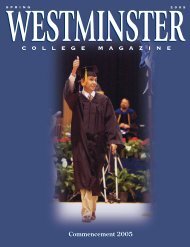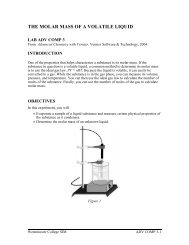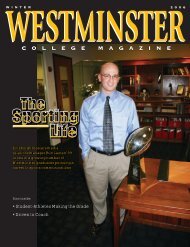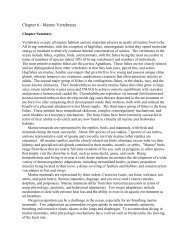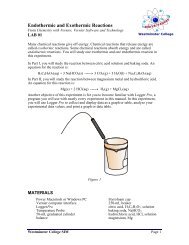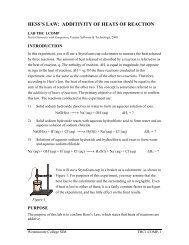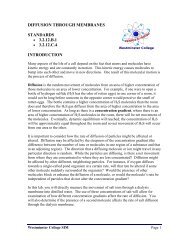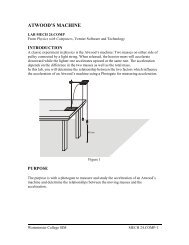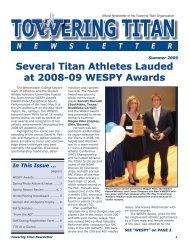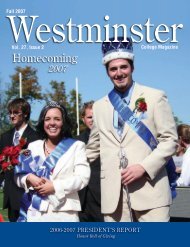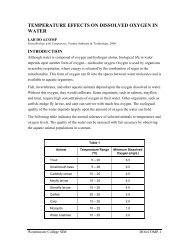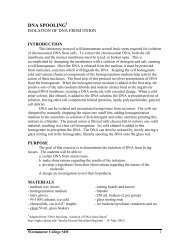INFRARED SPECTROSCOPY OF GASES - Westminster College
INFRARED SPECTROSCOPY OF GASES - Westminster College
INFRARED SPECTROSCOPY OF GASES - Westminster College
Create successful ePaper yourself
Turn your PDF publications into a flip-book with our unique Google optimized e-Paper software.
<strong>INFRARED</strong> <strong>SPECTROSCOPY</strong> <strong>OF</strong> <strong>GASES</strong>Introduction:The infrared spectrometer can be used to detect the presence of various components in amixture of gases, such as carbon dioxide in breath or in the atmosphere. The IR can detect bondswhich are polar covalent. For our purposes, this means two dissimilar atoms (i.e. C=O and C-Hbonds can be detected but not N≡N or O=O).In this experiment infrared spectrophotometry will be used to quantitatively determinethe percent of carbon dioxide in one's breath as well as in the atmosphere.Purpose:The purpose of this experiment is to quantitatively determine the percentage of carbondioxide in one's breath and in the atmosphere using an infrared spectrometer.Equipment / Materials:FTIRballoons (7-9” round)Dry ice (or another source of CO 2 )meter stickair source (bicycle pump or compressedair)heliumstringSafety:• Always wear safety glasses and an apron in the lab.<strong>Westminster</strong> <strong>College</strong> – SIM 1 of 7
12. Subtract the background scan from the scan of the balloon containing your breath andsave it in C. Record the peak(s) of carbon dioxide and the absorbance at each peak. Plotthe spectrum.13. Using a bicycle pump, inflate a balloon with air to approximately the same volume as thebackground balloon. Determine the circumference of the balloon and record it in the datatable. Take a scan of this balloon and save it in A.14. Subtract the background scan from the scan of the balloon containing air and save it in A.Record the peak(s) of carbon dioxide and the absorbance at each peak. Plot the spectrum.<strong>Westminster</strong> <strong>College</strong> – SIM 3 of 7
Name_______________________________Name_______________________________Period______________________________Date________________________________<strong>INFRARED</strong> <strong>SPECTROSCOPY</strong> <strong>OF</strong> <strong>GASES</strong>Data Table:Diameter of helium balloon _____________Volume of helium balloon_____________Diameter of carbon dioxide balloon _____________Volume of carbon dioxide balloon_____________Peak(s) for CO 2____________cm -1____________cm -1____________cm -1Absorbance___________________________Diameter of partially filled balloon (He) _____________Volume of partially filled balloon (He) _____________Diameter of He/CO 2 balloon _____________Volume of He/CO 2 balloon_____________Peak(s) for CO 2____________cm -1____________cm -1____________cm -1Absorbance___________________________<strong>Westminster</strong> <strong>College</strong> – SIM 4 of 7
Diameter of balloon containing your breath _____________Volume of balloon containing your breath_____________Peak(s) for CO 2____________cm -1____________cm -1____________cm -1Absorbance___________________________Diameter of balloon containing airVolume of balloon containing airPeak(s) for CO 2____________cm -1____________cm -1____________cm -1__________________________Absorbance___________________________Calculations:1. Calculate the volume of each balloon and record it in the data table.2. Correct the absorbance for the volume of the balloon.Absorbance of unknownVolume of unknown balloonCorrected absorbance of unknown=Volume of pure CO 2 balloon<strong>Westminster</strong> <strong>College</strong> – SIM 5 of 7
Corrected Abs of unknown % of CO2in unknown3. Using the equation, =Abs of pure CO2100 % (pure CO 2)a. determine the percent of carbon dioxide in the He/CO 2 mixture.b. determine the percent of carbon dioxide in your breath.c. determine the percent of carbon dioxide in air.Substance Corrected abs % CO 2He/CO 2 mixturebreathairQuestions:1. Why was helium used in the background?2. Why was the He/CO 2 mixture analyzed?3. How would the CO 2 content in your breath change under the following conditions?a) Jog a kilometer?b) Breathe helium from a helium balloon?c) Hold your breath as long as possible before filling the balloon?<strong>Westminster</strong> <strong>College</strong> – SIM 6 of 7
<strong>INFRARED</strong> <strong>SPECTROSCOPY</strong> <strong>OF</strong> <strong>GASES</strong> - TEACHER NOTESLab Time: 25-30 minutesPreparations:Time: 5 minutesAnswers to Questions:1. Why was helium used in the background?Helium will not absorb in the infrared region and, thus, only the balloon's scan isobtained.2. Why was the He/CO 2 mixture analyzed?In order to test the procedure and make the unknown results more reliable.3. How would the CO 2 content in your breath change under the following conditions?a) Jog a kilometer?CO 2 content would be increased.b) Breathe helium from a helium balloon?CO 2 content would be decreased.c) Hold your breath as long as possible before filling the balloon?CO 2 content would be increased.Considerations:When students interpret the IR spectra, only the left hand side (1500 - 4000 cm -1 ) isneeded. Have the students identify at least one major peak for the pure CO 2 spectrum. Thispeak(s) should be used throughout the remainder of the experiment. The peaks may shift a fewwavenumbers either way from scan to scan. Use the peak(s) closest to the recorded peak(s) forpure CO 2 . The color of the balloons should not interfere in the infrared region, however, it isbest to use the same sized balloons and brand of balloons throughout the experiment. Carbondioxide should show an absorbance around 2400 cm -1An extension of this experiment would be to determine the percent of carbon monoxidein automobile exhaust. This can be accomplished using carbon monoxide in place of carbondioxide. Be sure adequate ventilation is available if using carbon monoxide. Use a bicyclepump to collect air samples at the exhaust system of a car which is idling.<strong>Westminster</strong> <strong>College</strong> – SIM 7 of 7



